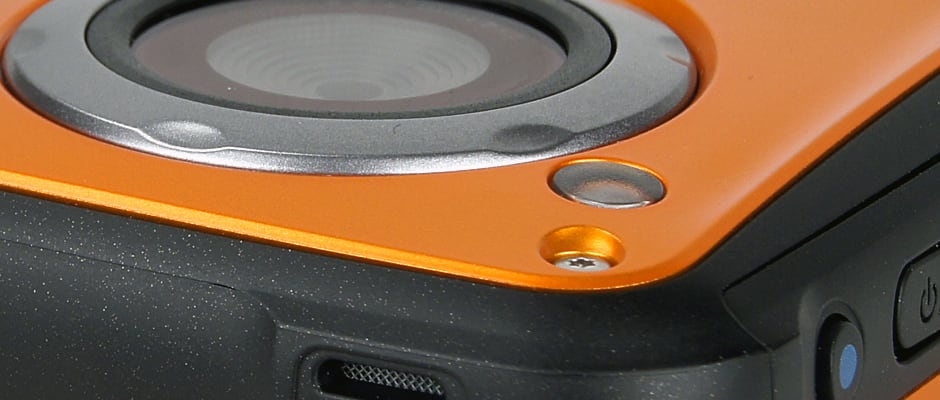Pros
Cons
Introduction
Front
{{section_header}}{{section.name}}{{/section_header}}

Back
{{section_header}}{{section.name}}{{/section_header}}

Left
{{section_header}}{{section.name}}{{/section_header}}
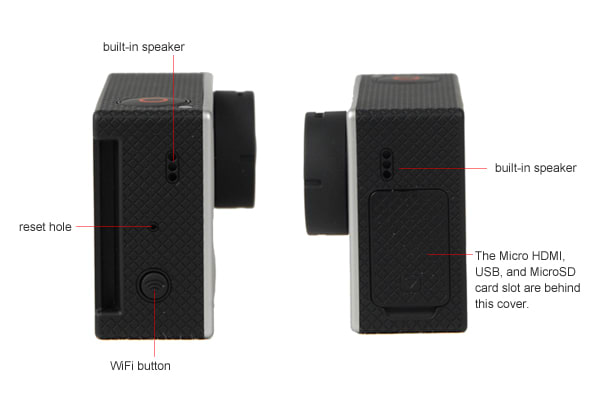
Right
{{section_header}}{{section.name}}{{/section_header}}
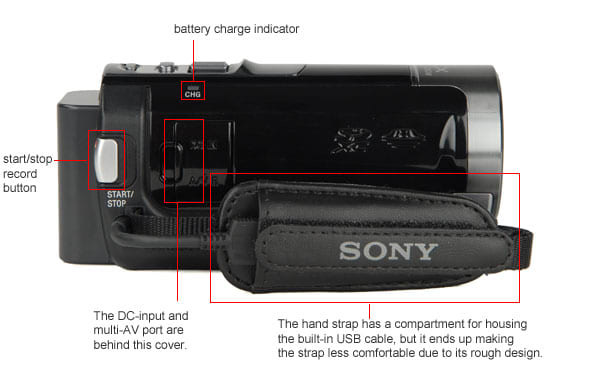
Top
{{section_header}}{{section.name}}{{/section_header}}

Bottom
{{section_header}}{{section.name}}{{/section_header}}

In the Box
{{section_header}}{{section.name}}{{/section_header}}

Panasonic includes the following items with the HM-TA20:
• instruction manual
• wrist strap
• USB extender
• miniature tripod
Color
{{section_header}}{{section.name}}{{/section_header}}
The HM-TA20 managed a color error of 7.4 in our bright light testing, which doesn't suggest very good color accuracy for the camcorder. This is slightly worse than the color error we measured on last year's Panasonic HM-TA1, but it is better than the other two camcorders we compared it to. A traditional HD camcorder in the $300 - $500 price range would generally yield much better results in this test than the HM-TA20. More on how we test color.
The HM-TA20 does have a color effects menu, but the options only include sepia, black and white, and a soft skin mode. We've included a sample image taking from our test clip of soft skin mode, but you probably won't be able to see much difference between it and the regular record mode on the TA20. At least, we weren't able to see much of a difference in our testing, despite the fact that Panasonic claims soft skin mode helps smooth skin tones on your videos. This may be the case in certain situations, but don't expect the effect to offer wild improvements.
We never expect top-notch color accuracy with ultracompact or budget camcorders, mainly because those camcorders rarely offer a manual white balance feature. Using auto white balance, cheap camcorders tend to have difficulty producing accurate colors under certain indoor lights—like the tungsten bulbs we use for our bright light test. Taking this into consideration, the TA20's color accuracy numbers aren't all that bad (and the 99.9% saturation level is very good), but we are disappointed that the camcorder didn't show any improvement over last year's Panasonic HM-TA1.
{{comparison_bars title="Color Score Comparison", attribute="Color Score", xLabel="Color Score"}}
Low Light Color
{{section_header}}{{section.name}}{{/section_header}}
The HM-TA20, like many camcorders of its class, offered more accurate colors in low light than it did in our bright light test. The results weren't stellar, but the TA20 managed a color error of 4.39 under our 60 lux low lights and a saturation level of 88%. These numbers are very consistent with what we saw from the Panasonic TA1, and they are a tad better than what the Kodak PlaySport Zx5 and JVC GC-WP10 offered in this test. More on how we test low light color.
We like the vibrant look of the colors produced by the TA20 in our low light test, but certain blues and purples may have skewed a bit too dark for some people's tastes. Overall, this is a good color score for the little camcorder, and it is part of a strong low light video performance overall.
Noise
{{section_header}}{{section.name}}{{/section_header}}
Noise results for the HM-TA20 came in higher than we expected in our bright light test. The camcorder's video clip showed an average of 0.88% noise, which is more noise than we usually see from consumer camcorders (even cheap, ultracompact models). It is also nearly the same amount of noise we measured on the Panasonic HM-TA1 last year. More on how we test noise.
{{comparison_bars title="Noise Score Comparison", attribute="Noise Score", xLabel="Noise Score"}}
Low Light Sensitivity
{{section_header}}{{section.name}}{{/section_header}}
The HM-TA20 was able to record a decent video image without requiring all that much illumination. In our test, the camcorder needed just 5 lux of light to capture an image considered worthy for broadcast television (that's 50 IRE on a waveform monitor). This is a better low light sensitivity than we usually see for a consumer camcorder, although it is nearly the same amount of light that the Kodak PlaySport Zx5 required.
These ultracompact models often need less light than the larger, more traditional HD camcorders. This is due to the fact that cheap, pocket cams often have fixed lenses, which means the apertures for the lens are consistently set at a very wide f-stop. These models also tend to have low light settings such as slow shutters that kick in automatically—without the ability to turn them off. For higher-end camcorders we will turn these special low light settings off during this test. More on how we test low light sensitivity.
Anyway, the point is the HM-TA20 is able to record fairly bright video without much light. The best thing we can say is that Panasonic improved the TA20 a lot in this category over last year's HM-TA1 (which needed 12 lux of light to pass this test). So, even compared to other ultracompact models, the TA20 is ahead of the pack in terms of low light sensitivity.
{{comparison_bars title="Low Light Sensitivity Comparison", attribute="Low Light Sensitivity Score", xLabel="Low Light Sensitivity Score"}}
Low Light Noise
{{section_header}}{{section.name}}{{/section_header}}
The Panasonic HM-TA20 registered a bit more noise in its low light videos than its bright light videos, which is perfectly acceptable. In fact, that camcorder's low light noise performance was very good compared to what we've seen from other camcorders in this test. The TA20 averaged 1.1% noise in low light, which is a slight improvement over last year's TA1 (not by much), and in a similar ballpark to the Kodak PlaySport Zx5 and JVC GC-WP10. In the end, all of these camcorders were good at limiting the amount of noise in low light, and that's something we can't always say about cheap consumer camcorders. More on how we test low light noise.
{{comparison_bars title="Low Light Noise Score Comparison", attribute="Low Light Noise Score", xLabel="Low Light Noise Score"}}
Low Light Color
{{section_header}}{{section.name}}{{/section_header}}
The HM-TA20, like many camcorders of its class, offered more accurate colors in low light than it did in our bright light test. The results weren't stellar, but the TA20 managed a color error of 4.39 under our 60 lux low lights and a saturation level of 88%. These numbers are very consistent with what we saw from the Panasonic TA1, and they are a tad better than what the Kodak PlaySport Zx5 and JVC GC-WP10 offered in this test. More on how we test low light color.
We like the vibrant look of the colors produced by the TA20 in our low light test, but certain blues and purples may have skewed a bit too dark for some people's tastes. Overall, this is a good color score for the little camcorder, and it is part of a strong low light video performance overall.
Motion
{{section_header}}{{section.name}}{{/section_header}}
Using the TA20's highest-quality record mode (1920 x 1080 Full HD) produced video that was decently sharp, but had some significant problems. We saw more artifacting than we noticed from the competition, and there was a lot of interference in our motion test. The same jagged lines and blocky pixelation we've seen from the JVC GC-WP10 was noticeable on the HM-TA20 (although not quite as bad as the JVC produced). Overall, the motion video looked like a bit of a downgrade from the Panasonic HM-TA1, but not by much. On the bright side, the video was fairly blur free and trailing wasn't an issue.
The 720p record mode showed us more artifacting and more of the pixelation-like interference we mentioned above. The mode didn't improve smoothness all that much, and its overall quality was quite a bit worse than the 1920 x 1080 record mode. The camcorder uses a 30p frame rate to record video in all record modes. More on how we test motion.
Video Sharpness
{{section_header}}{{section.name}}{{/section_header}}
While many of the images we pulled from the TA20's video tests looked rather sharp, we noticed the camcorder had a drop in sharpness whenever we shot subjects in motion (or moved the camcorder while recording). This was confirmed by our sharpness test where the TA20 managed a horizontal sharpness of 600 lw/ph and a vertical sharpness of 575 lw/ph. Both of these scores represent a slight downgrade from the Panasonic TA1, as well as being lower than the Kodak Zx5 and JVC GC-WP10's scores in this test. More on how we test video sharpness.
{{comparison_bars title="Video Sharpness Score Comparison", attribute="Video Sharpness Score", xLabel="Video Sharpness Score"}}
Stabilization
{{section_header}}{{section.name}}{{/section_header}}
Panasonic did put an electronic (aka digital) image stabilization feature on the TA20, but the setting cannot be turned off. This makes it impossible for us to test using our shaker system. We can't see if there's any improvement when using the stabilization feature vs. when the feature is turned off, thus we can't report on our findings. The fact that the camcorder includes image stabilization is good, but it's becoming more and more common for ultracompact camcorders to have a stabilization feature like this. More on how we test stabilization.
Testing Samples
{{section_header}}{{section.name}}{{/section_header}}
Ease of Use
{{section_header}}{{section.name}}{{/section_header}}
Ease of use is an important part of the HM-TA20, as is the case for all ultracompact camcorders. With this model, you aren't getting the best image quality, but with that sacrifice you should get a more portable and simpler device. Compared to similar pocket-cams, the HM-TA20 is a bit more complicated than the norm. It has a few more features, a bulkier design, and a confusing interface than your average ultracompact model. Part of this complication stems from the fact that it is waterproof (hence the complex locking system for the port covers), but we also think Panasonic couldn't help itself from adding extra features to the TA20. Panasonic is, after all, one of the leaders in the camcorder industry, and the company is known for having lots of controls and features on its traditional camcorders.
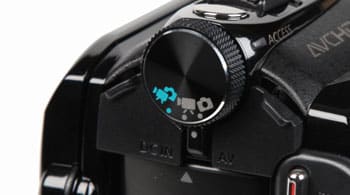
Auto Mode is confusingly called Dual Shot mode
The HM-TA20 would benefit from a slightly simpler design. The various record mode options in the menu system are confusing, and the presence of a low light mode and digital effects menu further complicate things. Why not set the low light mode to kick in automatically instead? We're sure there are people out there who will want this kind of control, but there's probably an equal number of users who will find themselves confused and overwhelmed by the HM-TA20. That's not to say this is an extremely difficult camcorder to figure out. It's actually very simple compared to a traditional model. But is it easy enough for your techno-illiterate grandmother to use it? Probably not. This isn't a model that's as simple as the Flip, and it's even a bit more complicated than the Kodak PlaySport Zx5.
Auto Mode
{{section_header}}{{section.name}}{{/section_header}}
The HM-TA20 has no manual controls, so 95% of your shooting with the device will be done using the camcorder's iA or Intelligent Auto mode. This is the default mode on the camcorder, and its features are similar to the iA mode found on Panasonic's other consumer camcorders. The only other recording mode besides iA is the night mode, which you must activate manually from the menu system.
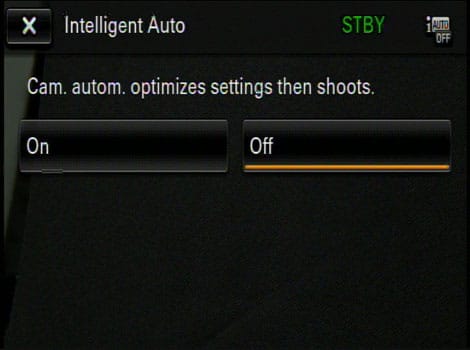
The iAuto mode button is difficult to find, but when you do find it the option for turning on the mode looks like this.
Auto Controls
{{section_header}}{{section.name}}{{/section_header}}
According to Panasonic, when the HM-TA20 is in record mode its iA setting will automatically select a scene mode appropriate to the shooting conditions. This scene mode is selected by just pointing the camcorder at your subject, but in our testing we rarely saw the TA20 automatically select any mode other than the regular iA setting. The instruction manual claims there are six automatic scene modes: Portrait, Scenery, Spotlight, Night Portrait, Night Scenery, and Macro. Like we said, however, we rarely saw the camcorder select any of these modes, and most of them we never saw at all.
The only thing we did notice repeatedly was the TA20's face detection function, which places a small box around up to three faces within the video frame. While this did occur often, we found the camcorder had some trouble actually exposing these faces properly—even after they had been detected for a few seconds. Exposure functions weren't terrible, but the camcorder was very slow to switch between light and dark scenes.
The HM-TA20 has a fixed lens, so there isn't really an autofocus mechanism on the camcorder. This means your videos should always be in focus as long as you record farther back than one foot, which is the minimum focus distance for the TA20 according to Panasonic. This minimum focus distance isn't too bad, and there are many ultracompact models that have minimum distances of 2-3 feet instead.
Handling
{{section_header}}{{section.name}}{{/section_header}}
The Panasonic HM-TA20 has a rugged and durable design, as any waterproof camcorder should, but we were upset by its lack of grip and odd flattened-out shape. Starting with the waterproof function, which allows the TA20 to be used at depths up to 10 feet (3 meters), we noticed that the camcorder's various port covers all have locking mechanisms and rubber inserts to keep water out of these important areas. The two actual port covers did a decent job here, but the sliding cover on the bottom of the camcorder that protects the memory card slot was not well designed. Sliding this cover open, we accidentally pushed some water into the memory card slot area—not much, but some—which is not something that should be this easy to do.

We also found the camcorder retained quite a bit of liquid even after we took it out of the water and dried it off. This was especially true for the area around the start/stop record button on the back of the camcorder (water would drip out of this area the few times we pressed the button even after drying the camcorder off). Water also collected in the holes around the built-in microphone and other indentations on the camcorder. This leaves us to wonder why Panasonic didn't make the TA20 with a smoother, more streamlined surface (like Kodak did with the Zx5).

There's a little screen lock button on the side of the TA20 that allows the camcorder to be used underwater without water pressure affecting the touchscreen accidentally. When you press the screen lock button, a little message even pops up reminding you to lock all the port covers before using the TA20 underwater. We wish this message screen would show for a bit longer, though, as it is difficult to read everything in the time it appears on the screen

The TA20 has a flat, thin design that can be difficult to grip because it is so wide. The camcorder is basically a true rectangle, which means there are no contours or ergonomic slopes to help it fit into the palm of your hand more comfortably. This is something we clearly missed from the TA20, although we do like its rugged design. According to Panasonic, the TA20 can take a drop safely from 5 feet (1.5m) or less. Panasonic does include a small wrist strap with the camcorder, so at least you have that to prevent some drops. Also on the hand strap is a small stylus pen that can be used in conjunction with the touchscreen interface on the LCD. We can't imagine that many people actually using this stylus pen, however, and we expect most users to question what the little piece of gray plastic on the wrist strap is in the first place (the instruction manual explains its purpose as a stylus pen, that's how we know).
We do like the small tripod that ships with the HM-TA20, and it can be useful for setting up interviews, or recordings of live events where you may not want to be holding the camcorder the whole time. Of course, the 30-minute clip length limit on the camcorder makes recording long events more of a pain that in should be.

These dedicated buttons give you quick access to aperture and shutter speed controls.
Portability
{{section_header}}{{section.name}}{{/section_header}}
The Panasonic HM-TA20 weighs 155g with an SD card loaded in its memory card slot. That may sound light to those used to dealing with traditional camcorders, but it is close to average for an ultracompact model—especially when compared to other waterproof camcorders. The TA20 is only 10g heavier than the Kodak PlaySport Zx5, and the dimensions of the two camcorders are nearly the same give or take a few millimeters. But the Zx5 has a more shapely design that fits better into the palm, so it looks a bit more compact than the TA20 even though it isn't all that much smaller. The hard numbers for the TA20 are: 64.3 x 112.6 x 17.7mm (2.5 x 4.4 x 0.7 inches).
The fact that the TA20 is waterproof does make it more portable than, say, the Panasonic TA1 or TA2. You don't have to worry about it getting wet in the bottom of a beach bag or in your pocket during an unexpected thunderstorm. This literally makes it "more portable" in every sense of the word. The long width of the TA20 is a bit cumbersome, however, and it looks as if the camcorder has been flattened out by a steamroller. At least it isn't as boxy or clunky as the waterproof JVC GC-WP10, though, and its slim design should make it easy to slip in and out of your pocket.
Battery Life
{{section_header}}{{section.name}}{{/section_header}}
The Panasonic HM-TA20 lasted for just over 105 minutes (1 hour, 45 minutes) in our battery life test. We conducted this test by letting the camcorder continually record video until its battery depleted (the same way we do all our battery life tests). This isn't a great battery life performance, but it is better than average for an ultracompact camcorder. The JVC GC-WP10, for example, lasted for just 82 minutes in this test, and the Panasonic HM-TA1 went for just 91 minutes. More on how we test battery life.
The HM-TA20 does not have a removable battery pack, which is something of a downside. Replacing an old or worn-out battery is a hassle, although the instruction manual does provide instructions on how to do so (it involves using a tiny screw driver and opening up the TA20 so you can get to its innards). The internal battery design also means you can't swap out a fresh battery when your original one becomes depleted—a practice that is very common for people who take their camcorders out for a long day of shooting. Charging the internal battery is done using the USB arm on the camcorder, as there is no dedicated DC-input that can be used for charging. This is also a bit of a downside, although USB-wall-plug chargers are getting more and more common these days.

LCD
{{section_header}}{{section.name}}{{/section_header}}
If you look at the specs for the HM-TA20 you'll notice the camcorder's LCD is listed as being a 3-inch screen. This is somewhat misleading, however, as the full size of the screen isn't usable when recording video. A big chunk of the screen—roughly 1/2 of it—is taken up by the onscreen controls like zoom, the menu buttons, etc. This leaves a tiny portion of the LCD that you can actually use to frame your video, and, frankly, it's not enough space. Adding to the frustration is the fact that the screen has a limited resolution of just 230,000 pixels.
You can only use the full size of the 3-inch screen in playback mode. If you rotate the TA20 to its side and hold it horizontally, the video will rotate and fill the screen entirely for your viewing pleasure. You can also view videos holding the camcorder vertically, but you'll be stuck with that same 1.5-inch portion of the screen you see in record mode.
We've seen this exact screen interface before on other ultracompact models. The Flip SlideHD had the same concept, and the Sony Bloggie camcorders have a similar screen design. The difference with the Sony Bloggie cams, however, is that you can record holding the camcorder horizontally (with the screen frame filled entirely). This is not possible with the HM-TA20.
Stabilization
{{section_header}}{{section.name}}{{/section_header}}
Panasonic did put an electronic (aka digital) image stabilization feature on the TA20, but the setting cannot be turned off. This makes it impossible for us to test using our shaker system. We can't see if there's any improvement when using the stabilization feature vs. when the feature is turned off, thus we can't report on our findings. The fact that the camcorder includes image stabilization is good, but it's becoming more and more common for ultracompact camcorders to have a stabilization feature like this. More on how we test stabilization.
Manual Focus
{{section_header}}{{section.name}}{{/section_header}}
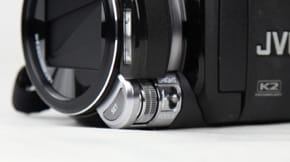
The adjustment dial makes accurate focus adjustments easy.
Manual Exposure
{{section_header}}{{section.name}}{{/section_header}}
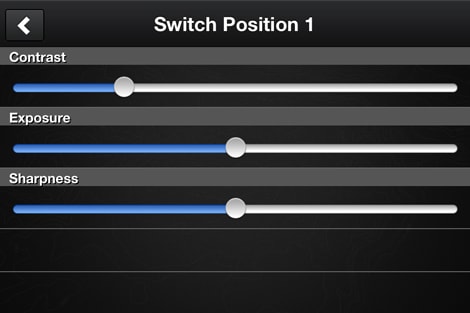
The manual exposure controls are only found on the Contour app, not on the camcorder itself.
Miscellaneous Controls
{{section_header}}{{section.name}}{{/section_header}}
Night Mode
The night mode (called Night View in the TA20's instruction manual) boosts low light performance by allowing the camcorder to use slower shutter speeds than are normally acceptable (basically, a shutter speed of 1/30 of a second). The mode may also increase gain a bit as well and it is represented by a moon and star icon. The night mode is the only other shooting mode on the TA20 other than the camcorder's basic auto mode (iA or Intelligent Auto). When the camcorder is in iA mode and the scene becomes dark, a flashing image of the night mode icon appears on the screen to let you know you should switch over to night mode for better illumination.
Auto Controls
{{section_header}}{{section.name}}{{/section_header}}
According to Panasonic, when the HM-TA20 is in record mode its iA setting will automatically select a scene mode appropriate to the shooting conditions. This scene mode is selected by just pointing the camcorder at your subject, but in our testing we rarely saw the TA20 automatically select any mode other than the regular iA setting. The instruction manual claims there are six automatic scene modes: Portrait, Scenery, Spotlight, Night Portrait, Night Scenery, and Macro. Like we said, however, we rarely saw the camcorder select any of these modes, and most of them we never saw at all.
The only thing we did notice repeatedly was the TA20's face detection function, which places a small box around up to three faces within the video frame. While this did occur often, we found the camcorder had some trouble actually exposing these faces properly—even after they had been detected for a few seconds. Exposure functions weren't terrible, but the camcorder was very slow to switch between light and dark scenes.
The HM-TA20 has a fixed lens, so there isn't really an autofocus mechanism on the camcorder. This means your videos should always be in focus as long as you record farther back than one foot, which is the minimum focus distance for the TA20 according to Panasonic. This minimum focus distance isn't too bad, and there are many ultracompact models that have minimum distances of 2-3 feet instead.
Audio Controls
{{section_header}}{{section.name}}{{/section_header}}
For an ultracompact camcorder, the HM-TA20 has a good set of audio features. Its built-in mic records 2-channel stereo audio, and the camcorder has a 3.5mm external mic jack that allows you to record audio with whatever kind of microphone you want. There is no audio level control on the camcorder, but there is a special voice record mode that allows you to use the TA20 has a portable audio recorder (for recording speeches, lectures, voice notes, etc.). The camcorder offers options for PCM audio recording (the highest quality setting), and three AAC record modes (one at 256kbps and two at 128kbps). You can also snap photos when the camcorder is in voice record mode, just in case you want to match an image with an audio clip.
Editing
{{section_header}}{{section.name}}{{/section_header}}
Loaded on the TA20 itself is an editing program called HD Writer PE 2.0. The PE probably stands for "pocket edition" as this software is the same program that came on last year's TA1, although it has been updated to version 2.0. For an overview of the software that ships with this and other camcorders, see our article: Video Editing Software For Your Camcorder{{product.brand.name}}-Included-Software.htm.
In addition to this provided software, there is a built-in editing feature on the camcorder that allows you to trim or split clips, although the interface for doing so is terrible. Also this feature only appears onscreen when you hold the camcorder horizontally in playback mode, which is very strange. There is also an option for capturing still images from playback in the editing submenu.
Additionally, when you hold the camcorder horizontally an upload tag button appears on the LCD. This allows you to tag clips so you can upload them later, using Panasonic's provided software. This feature does not upload the videos automatically—you still must do this using the HD Writer PE 2.0 software (or using your own upload methods). It simply tags the clips so that the HD Writer software recognizes them as files you want to upload.
Compression
{{section_header}}{{section.name}}{{/section_header}}
The HM-TA20 records Full HD video using a compression system based on the MPEG-4 codec. It does not use AVCHD compression, which is the norm for more traditional HD camcorders (and is also based on MPEG-4). The basic MPEG-4 compression used by the HM-TA20 allows for smaller file sizes than the bulky AVCHD, which is why it is commonly used on ultracompact camcorders like the TA20.
In addition to the 1920 x 1080 Full HD record mode, the HM-TA20 has three other recording options, all of which are shown in the table below. The standard definition mode is useful for a situation where you want smaller file sizes and don't care about the quality of your video all that much. The iFrame option is a high-quality standard def setting that is meant to produce files easy to work with on a Mac computer (using iMovie).
During our battery test, we noticed the HM-TA20 had a clip limit length of 29 minutes, 59 seconds. If a single clip reached this length, recording would automatically cease. In order to continue recording, you had to press the start/stop record button once again. We doubt this clip length limit will be a huge deal for most people, but we wonder why Panasonic couldn't have the camcorder automatically start recording a new clip when the limit is reached. Panasonic also notes that the iFrame record mode has a clip length limit of approximately 20 minutes. Read more about the advantages and disadvantages of various high definition compression types.
Media
{{section_header}}{{section.name}}{{/section_header}}
The Panasonic TA20 records to all types of SD memory cards, and that includes SDHC and new SDXC cards (which offer higher-capacity options than regular SD cards). The cards, all of which are the same physical size, fit into the card slot on the bottom of the camcorder. The slot can be hard to open, as it is covered by a locking tab for waterproof purposes. You must unlock the door, then slide it open to reveal the card slot.
The TA20 does contain a very small amount of built-in memory, but don't expect to rely on it for more than one or two seconds of video. This internal memory is there to store the camcorder's built-in editing software, it is not meant to provide enough space to save video recordings. Read more about the advantages and disadvantages of various media types.

Slow Motion Modes
Still Features
{{section_header}}{{section.name}}{{/section_header}}
You can take photos with the Panasonic HM-TA20, but you must do so by switching the camcorder to its dedicated still image mode. That means no photos can be taken during recording, which is a feature found on most traditional camcorders. In the dedicated photo mode you can take photos at four different resolution options: 3264 x 2448 (8 megapixels), 1920 x 1080 (2 megapixels), 1600 x 1200 (2 megapixels), or 640 x 480 (0.3 megapixels). There's also a self-timer function on the camcorder that can be used to take photos on a delayed setting.
While the 8-megapixel option sounds great on paper, the actual quality of this mode is suspect. The camcorder's effective pixel count is just over 5 megapixels, and its total pixel count is around 5.33 megapixels. This means there's a lot of interpolation and resizing being performed by the camcorder with its 3264 x 2448 photo mode, and the actual photo includes far less than eight million real pixels. The camcorder's 2-megapixel photo modes don't have any interpolation, so they may end up producing higher-quality photos overall.
Lens & Imaging System
{{section_header}}{{section.name}}{{/section_header}}

Like many camcorders of its class, the HM-TA20 has a fixed lens. This means the lens has no moving parts, hence a fixed aperture and focal length (as you can see from the table below). The TA20's fixed aperture of f/2.8 isn't all that wide, but the camcorder did a decent job in our low light tests regardless. A fixed lens also means no optical zoom for the camcorder, so don't get fooled by Panasonic's specs that talk about a 4x zoom (it's digital, not optical).
The camcorder is equipped with a 5.33-megapixel 1/4.1-inch CMOS sensor, which is roughly the same size sensor you find in Panasonic's mid-range HD camcorders. Some ultracompact models have bigger sensors than this, while others have ones of a similar size. We don't want to put too much emphasis on the sensor, though, as it is just one of many aspects that determines a camcorder's overall image quality and performance.
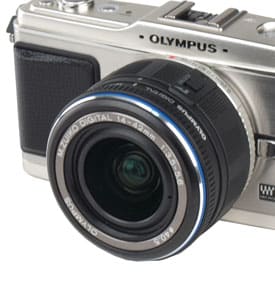
LCD
{{section_header}}{{section.name}}{{/section_header}}
If you look at the specs for the HM-TA20 you'll notice the camcorder's LCD is listed as being a 3-inch screen. This is somewhat misleading, however, as the full size of the screen isn't usable when recording video. A big chunk of the screen—roughly 1/2 of it—is taken up by the onscreen controls like zoom, the menu buttons, etc. This leaves a tiny portion of the LCD that you can actually use to frame your video, and, frankly, it's not enough space. Adding to the frustration is the fact that the screen has a limited resolution of just 230,000 pixels.
You can only use the full size of the 3-inch screen in playback mode. If you rotate the TA20 to its side and hold it horizontally, the video will rotate and fill the screen entirely for your viewing pleasure. You can also view videos holding the camcorder vertically, but you'll be stuck with that same 1.5-inch portion of the screen you see in record mode.
We've seen this exact screen interface before on other ultracompact models. The Flip SlideHD had the same concept, and the Sony Bloggie camcorders have a similar screen design. The difference with the Sony Bloggie cams, however, is that you can record holding the camcorder horizontally (with the screen frame filled entirely). This is not possible with the HM-TA20.
Connectivity
{{section_header}}{{section.name}}{{/section_header}}
Along with the aforementioned external mic jack, the HM-TA20 has a built-in USB arm and an HDMI terminal. All three of these ports are protected by locking port covers with rubberized seals in an attempt to keep them free from water when the TA20 is submerged. These locking mechanisms do make the ports more difficult to access, but something like this is necessary to keep the TA20 completely waterproof.
All the ports are located on the left side of the HM-TA20. There are two separate locking doors on this side starting with a larger one near the top of the camcorder that covers the HDMI and 3.5mm external mic jack. There are two different switches for opening this door, with one acting as a "lock" and the other actually opening the door when triggered (as long as the lock switch isn't closed). In between the two ports here is a tiny reset button for returning the TA20 to its default settings.
Near the bottom of the camcorder, but on the same side as the other ports, is a slightly smaller port cover that also has a locking switch and an opening switch. After opening this cover you'll find the camcorder's built-in USB arm, although you may not see it at first. To release the arm you must press the little gray button inside this compartment (yes, we know this is a lot of buttons and switches to press just to get to the USB port). After pressing this button, the USB arm pops out and is ready to connect to a computer. Of course, it doesn't pop out very far, so you may have trouble inserting the arm into computers without using the USB extending cable that comes with the TA20. This cable gives the camcorder more flexibility and reach so you can connect the TA20 via its USB arm.
Battery
{{section_header}}{{section.name}}{{/section_header}}
The HM-TA20 does not have a removable battery pack, which is something of a downside. Replacing an old or worn-out battery is a hassle, although the instruction manual does provide instructions on how to do so (it involves using a tiny screw driver and opening up the TA20 so you can get to its innards). The internal battery design also means you can't swap out a fresh battery when your original one becomes depleted—a practice that is very common for people who take their camcorders out for a long day of shooting. Charging the internal battery is done using the USB arm on the camcorder, as there is no dedicated DC-input that can be used for charging. This is also a bit of a downside, although USB-wall-plug chargers are getting more and more common these days.

Media
{{section_header}}{{section.name}}{{/section_header}}
The Panasonic TA20 records to all types of SD memory cards, and that includes SDHC and new SDXC cards (which offer higher-capacity options than regular SD cards). The cards, all of which are the same physical size, fit into the card slot on the bottom of the camcorder. The slot can be hard to open, as it is covered by a locking tab for waterproof purposes. You must unlock the door, then slide it open to reveal the card slot.
The TA20 does contain a very small amount of built-in memory, but don't expect to rely on it for more than one or two seconds of video. This internal memory is there to store the camcorder's built-in editing software, it is not meant to provide enough space to save video recordings. Read more about the advantages and disadvantages of various media types.

Still Features
{{section_header}}{{section.name}}{{/section_header}}
You can take photos with the Panasonic HM-TA20, but you must do so by switching the camcorder to its dedicated still image mode. That means no photos can be taken during recording, which is a feature found on most traditional camcorders. In the dedicated photo mode you can take photos at four different resolution options: 3264 x 2448 (8 megapixels), 1920 x 1080 (2 megapixels), 1600 x 1200 (2 megapixels), or 640 x 480 (0.3 megapixels). There's also a self-timer function on the camcorder that can be used to take photos on a delayed setting.
While the 8-megapixel option sounds great on paper, the actual quality of this mode is suspect. The camcorder's effective pixel count is just over 5 megapixels, and its total pixel count is around 5.33 megapixels. This means there's a lot of interpolation and resizing being performed by the camcorder with its 3264 x 2448 photo mode, and the actual photo includes far less than eight million real pixels. The camcorder's 2-megapixel photo modes don't have any interpolation, so they may end up producing higher-quality photos overall.
Other Features
{{section_header}}{{section.name}}{{/section_header}}
Video Light
The camcorder is equipped with a tiny video light that will provide illumination assistance when shooting in low light environments. Frankly, the light is not very good. In our testing, it provided roughly 10 lux of light when we held it one or two feet away from a subject (about the same as a very bad flashlight). Farther away than that and the light almost did nothing to help out.
Effects
The HM-TA20 has a few color effects that allow you to record video (or take photos) in black and white, sepia, or using the soft skin detail setting. These options are found by selecting the artist's palette icon in the menu system.
Waterproof and shockproof design
If you've been reading this review, you should probably know by now that the HM-TA20 is a waterproof camcorder. The camcorder says so right on the front of its body (waterproof is written in italics), and on the right side of the camcorder you'll see the text: 3m/10ft WATERPROOF and 1.5m/5ft SHOCKPROOF. This waterproof depth of 3 meters or 10 feet is fairly standard for an ultracompact camcorder that is classified as waterproof. The Kodak PlaySport Zx5 and JVC GC-WP10 can both carry this depth threshold as well.
In our testing, we found the HM-TA20 to work decently underwater, and the presence of the built-in LED light on the camcorder did help illuminate subjects that were submerged (as long as you're about 2 feet away when you use the light). We checked the camcorder's ports for signs of water seepage after submerging the camcorder and found some traces of water in each of them. All the port covers have special rubberized seals, however, that kept the water from getting into the actual ports themselves. We found the most seepage in the memory card area, as the port cover must slide open to access the slot. This sliding function may cause some of the droplets to trickle dangerously close to the memory card slot when the door is opened, which is poor design on the Panasonic's part.
JVC Picsio GC-WP10 Comparison
Unlike Panasonic, Kodak doesn't make a ton of camcorders every year. Its market entirely focuses on ultracompact, pocket models, as well as a bunch of still image cameras that have video record modes. Not all of Kodak's cameras and camcorders are great, but the company's PlaySport series is a great example of a simple product that does what it is supposed to do very well.
Like the HM-TA20, the Kodak PlaySport Zx5 is waterproof up to 10 feet, and the camcorder also features a robust, durable design. We like the way the Zx5 fit into our hand better, though, and its surface is coated in a rubberized material that made the camcorder easier to grip both in and out of the water. As for image quality, the Kodak Zx5 showed a strong edge in our sharpness and motion tests, but the two models were very similar in terms of low light performance.
We give the PlaySport Zx5 the edge here because we like its design and interface a lot more than the TM20. Kodak chose not to implement a touchscreen design on the Zx5, and we think that's the right choice for a waterproof camcorder. The Zx5's buttons are well designed, its body is shapely and easy to hold, and its menu interface is simple (although not without a few quirks).
Panasonic HM-TA1 Comparison
The JVC GC-WP10 is a waterproof camcorder with some unforgivable design flaws. True, the camcorder did well in our performance tests, but using the WP10 was one of the most frustrating experiences we've had with a piece of modern technology. Its touchscreen interface was terrible, as was its thick and clunky design, and the processing power of the camcorder was abysmal. The WP10 would freeze up for a few seconds after you selected any menu option, and the process of simply moving from one menu screen to another took much longer than it should have.
We're not crazy about the design of the Panasonic HM-TA20 either, but it is definitely better than the JVC GC-WP10. It has a thinner frame and a slightly better grip (although it's still not good). We also like the touchscreen and interface on the Panasonic quite a bit better—even though both camcorders have some strong flaws. When it comes to waterproof camcorders with touchscreens, it seems both Panasonic and JVC have a long way to go, but Panasonic is at least a bit farther along at this point.
COMP 3
The HM-TA1 was Panasonic's first foray into the world of ultracompact or Flip-type camcorders. There was a lot we didn't like about the TA1, but we usually expect a number of faults in a first-generation product. The HM-TA20 isn't the direct successor to the TA1, as that would be Panasonic's HM-TA2, but the TA20 is part of the company's second-wave of ultracompact models (the TA1 and TA2 are not waterproof, thus they are more compact, but have most of the same features of the TA20).
We love the addition of a waterproof camcorder into Panasonic's repertoire, and there were a few design improvements that helped make the TA20 a less frustrating camcorder than the TA1. The touchscreen interface has its problems, but the overall durability of the TA20 is far better than what we experienced with the TA1. The image quality of the two camcorders isn't all that much different, and you could even argue the TA1 has a slight edge, but we did find the TA20 to be superior in low light. In the end, the two camcorders are probably even in overall video performance.
The TA20 represents an improvement for Panasonic over last year's TA1, but we'd like to see more. Despite the improvements, the TA20 is still not designed as well as the competition from Kodak, and its image quality performance was average for the most part.
Conclusion
It's hard to come clean with our true feelings about the Panasonic HM-TA20. We love its rugged, adventuresome design, but we can't say it is any better than the other waterproof camcorders we've tested—particularly the Kodak PlaySport series. In fact, the TA20 doesn't have the best grip due to its rigid design, and we did find its memory card slot area wasn't as protected from water as we would have liked it to be. We also weren't crazy about the camcorder's menu system and touchscreen interface, both of which had some confusing elements (particularly for beginners).
The TA20 performed admirably in our video testing, and there were certain categories (like color accuracy) where it was a bit ahead of the pack. But with ultracompact camcorders we like to put emphasis on ease of use and portability, and the TA20 was not the best model in either of these areas. Its wide, rectangular design, while still very compact, made the camcorder more difficult to slip in and out of a pocket than the Kodak PlaySport Zx5. We should give kudos to Panasonic for including a small tripod with the camcorder, however, and we do like the fact that the TA20 can stand upright on its own (that's where the wide bottom comes in handy).
When we reviewed the HM-TA1 last year, we came away disappointed with Panasonic's lack of ingenuity with the product. There was nothing special about the TA1 to set it apart from the rest of the ultracompact camcorder class. The same could be said about the TA20, but at least Panasonic tried a bit harder this time. The external mic jack and improved USB arm are welcomed additions on the TA20, and the recycled features like the built-in video light, dedicated audio record mode, and iFrame recording options do help elevate the camcorder's stature. Because there's not much out there to compare it to at the is point, the TA20 is currently one of the better waterproof camcorders we've reviewed. It isn't quite as good as the Kodak PlaySport Zx5 or Zx3, but it is definitely better than the GE DV1 and the JVC GC-WP10.
Photo Gallery
{{photo_gallery "Front Photo", "Left Photo", "Left Open Photo", "Back Photo", "Right Photo", "Top Photo", "Bottom Photo", "Lens Photo", "Lens Photo 2", "3D Lens Photo", "Media Photo", "Easy Mode Photo", "Manual Controls Photo", "Zoom Photo", "Zoom Photo 2", "Ease of Use Photo", "Battery Photo", "LCD Photo 1", "LCD Photo 2", "EVF Photo 1", "EVF Photo 2", "Mic Photo", "Mic Photo 2", "Ports Photo 1", "Ports Photo 2", "Ports Photo 3", "Ports Photo 4", "Ports Photo 5", "Ports Photo 6", "Handling Photo 1", "Handling Photo 2", "Handling Photo 3", "Handling Photo 4", "Box Photo"}}
Meet the tester
Jeremy is the video expert of our imaging team and Reviewed.com's head of video production. Originally from Pennsylvania and upstate NY, he graduated from Bard college with a degree in film and electronic media. He has been living and working in New England since 2005.
Checking our work.
Our team is here to help you buy the best stuff and love what you own. Our writers, editors, and experts obsess over the products we cover to make sure you're confident and satisfied. Have a different opinion about something we recommend? Email us and we'll compare notes.
Shoot us an email